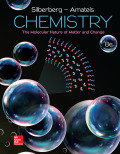
Interpretation:
The molality, molarity and mole fraction of
Concept introduction:
Molality is the measure of the concentration of solute in the solution. It is the amount of solute that is dissolved in one kilogram of the solvent. It is represented by
The formula to calculate the molality of the solution is as follows:
Molarity is defined as the number of moles of solute that are dissolved in one litre of solution. It is represented by
The formula to calculate the molarity of the solution is as follows:
The mole fraction is defined as the ratio of the number of moles of solute to the total number of moles in the mixture. It is represented by
The formula to calculate the mole fraction is as follows:
Answer to Problem 13.74P
The molality, molarity and mole fraction of the given solution of
Explanation of Solution
The formula to calculate the molality of the aqueous solution of
The formula to calculate the moles of a compound is as follows:
The formula to calculate the moles of
Substitute
The formula to calculate the mass of
Substitute
Substitute
The formula to calculate the molarity of the aqueous solution of
The formula to calculate the volume of the solution is as follows:
Substitute
Substitute
The formula to calculate the mole fraction of
Substitute
Substitute
The molality, molarity and mole fraction of the given solution of
Want to see more full solutions like this?
Chapter 13 Solutions
EBK CHEMISTRY: THE MOLECULAR NATURE OF
 ChemistryChemistryISBN:9781305957404Author:Steven S. Zumdahl, Susan A. Zumdahl, Donald J. DeCostePublisher:Cengage Learning
ChemistryChemistryISBN:9781305957404Author:Steven S. Zumdahl, Susan A. Zumdahl, Donald J. DeCostePublisher:Cengage Learning ChemistryChemistryISBN:9781259911156Author:Raymond Chang Dr., Jason Overby ProfessorPublisher:McGraw-Hill Education
ChemistryChemistryISBN:9781259911156Author:Raymond Chang Dr., Jason Overby ProfessorPublisher:McGraw-Hill Education Principles of Instrumental AnalysisChemistryISBN:9781305577213Author:Douglas A. Skoog, F. James Holler, Stanley R. CrouchPublisher:Cengage Learning
Principles of Instrumental AnalysisChemistryISBN:9781305577213Author:Douglas A. Skoog, F. James Holler, Stanley R. CrouchPublisher:Cengage Learning Organic ChemistryChemistryISBN:9780078021558Author:Janice Gorzynski Smith Dr.Publisher:McGraw-Hill Education
Organic ChemistryChemistryISBN:9780078021558Author:Janice Gorzynski Smith Dr.Publisher:McGraw-Hill Education Chemistry: Principles and ReactionsChemistryISBN:9781305079373Author:William L. Masterton, Cecile N. HurleyPublisher:Cengage Learning
Chemistry: Principles and ReactionsChemistryISBN:9781305079373Author:William L. Masterton, Cecile N. HurleyPublisher:Cengage Learning Elementary Principles of Chemical Processes, Bind...ChemistryISBN:9781118431221Author:Richard M. Felder, Ronald W. Rousseau, Lisa G. BullardPublisher:WILEY
Elementary Principles of Chemical Processes, Bind...ChemistryISBN:9781118431221Author:Richard M. Felder, Ronald W. Rousseau, Lisa G. BullardPublisher:WILEY





